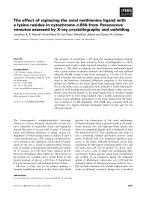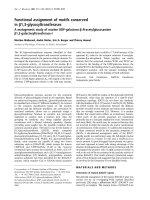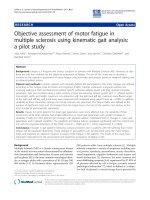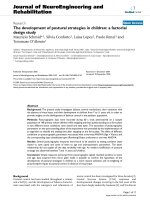Báo cáo hóa học: " Fine Splitting of Electron States in Silicon Nanocrystal with a Hydrogen-like Shallow Donor" ppt
Bạn đang xem bản rút gọn của tài liệu. Xem và tải ngay bản đầy đủ của tài liệu tại đây (465.74 KB, 7 trang )
NANO EXPRESS
Fine Splitting of Electron States in Silicon Nanocrystal
with a Hydrogen-like Shallow Donor
Vladimir A. Belyakov Æ Vladimir A. Burdov
Received: 7 July 2007 / Accepted: 16 October 2007 /Published online: 2 November 2007
Ó to the authors 2007
Abstract Electron structure of a silicon quantum dot
doped with a shallow hydrogen-like donor has been cal-
culated for the electron states above the optical gap. Within
the framework of the envelope-function approach we have
calculated the fine splitting of the ground sixfold degen-
erate electron state as a function of the donor position
inside the quantum dot. Also, dependence of the wave
functions and energies on the dot size was obtained.
Keywords Silicon nanocrystal Á Donor Á
Energy spectrum Á Fine splitting
Introduction
Introduction of shallow impurities into silicon quantum
dots is considered [1–5] as an efficient way to modify
optical properties of the dots. In connection to this, cal-
culations of electronic structure [6–11] and dielectric
function [12–18] of silicon nanocrystals doped with
V-group shallow donors have been carried out earlier.
The microscopic first-principles study of charge distribu-
tion and electrostatic fields in bulk silicon [19–21] and
silicon crystallites [16–18] in the presence of V-group
donors have shown existence of short-range and long-
range components of the electron–ion Coulomb interac-
tion in the system. The short-range potential differs from
zero only in a nearest vicinity (about Bohr radius) of the
donor nucleus. This extra potential, frequently named a
‘‘central-cell correction’’, leads to so-called valley–orbit
interaction [22, 23]. In turn, the valley–orbit interaction
causes the splitting of the electron ground state that is
sixfold degenerate if the spin variables have not been
taken into account. The degeneracy order exactly coin-
cides with the number of valleys in a conduction band of
bulk silicon. The long-range component represents stan-
dard e-times weakened Coulomb attraction between the
donor ion and electron.
Quantum confinement in nanocrystals considerably
strengthens the valley–orbit interaction and level splitting
[8–11] relative to the bulk systems [24]. Provided that the
valley–orbit interaction is strong, the sixfold degenerate
lowest energy level splits into three (if the donor occupies
the dot center) or six (if the donor position is arbitrary)
levels. In case of symmetric central-located donor position
in the nanocrystal the ground state splits into a singlet,
doublet, and triplet [8, 10, 11], as it takes place in the bulk
silicon [22, 23], the singlet level being strongly split off
from the doublet and triplet levels and always turns out to
be the lowest one.
However, not all the donors manifest strong valley–orbit
coupling. For example lithium, being interstitial donor of
the first group, has the splitting of about 1–2 meV [24]
which is one-two order less than that for V-group donors
such as P, As, Sb, and Bi. It is, therefore, logical to assume
also for quantum dots (without resorting to calculations),
that the valley–orbit splitting and central-cell effect for Li
will be weakened compared to the V-group donors by the
same order of magnitude. As was shown for 2–5 nm
nanocrystals [10, 11], maximal values of the splitting for
the V-group donors are of the order of several tenths of eV.
As a consequence, the valley–orbit splitting for Li in the
dot does not exceed, presumably, 10 meV. At the same
time, as will be shown below, the splitting caused by the
V. A. Belyakov (&) Á V. A. Burdov
Department of Theoretical Physics, University of Nizhniy
Novgorod, Nizhniy Novgorod 603950, Russia
e-mail:
123
Nanoscale Res Lett (2007) 2:569–575
DOI 10.1007/s11671-007-9101-5
long-range hydrogenic potential turns out to be consider-
ably greater (about 100 meV). This indicates a key role of
the hydrogenic potential compared to the central-cell one
for Li. On this reason, the hydrogenlike model may be
applied to a lithium donor in a silicon nanocrystal.
Therefore, when dealing with Li-doped dots, we shall
neglect the short-range central-cell field and, consequently,
the valley–orbit splitting.
In turn, for V-group donors in quantum dots, a contri-
bution of the long-range field to the energy splitting is 3–5
times less than that of the short-range field. In particular, in
the works of the authors [10, 11] electronic structure of
silicon crystallites doped with V-group donors has been
already calculated in the presence of both short- and long-
range Coulomb interactions. Note, however, that the results
of Refs [10, 11] may not be automatically extended to
Li-doped nanocrystals by zero setting the terms caused by
the short-range field. For V-group donors the central-cell
potential, being stronger than the hydrogenic one, imposes
certain symmetry to the Bloch states. The latter are
described by the functions possessing A
1
, E,orT
2
sym-
metry. Existence of the hydrogen-like potential leads to
some insignificant corrections only. In case of a lithium
donor, the situation is opposite. Precisely the hydrogen-like
potential is a dominant factor, while the valley–orbit
interaction is negligibly small. As a result, we have to use
different approaches to solve the problem. Consequently,
the solutions obtained in these two cases are appreciably
different.
In the present article we find the energies and wave
functions of the ground and several excited electronic
states of silicon quantum dot with a lithium donor that may
be treated as a shallow hydrogenic one. We shall also
discuss an effect of degeneracy removal caused by the
presence of a hydrogenlike center in an arbitrary place
inside the dot, and calculate the splitting of the lowest
energy level being sixfold degenerate initially.
For this purpose we employ envelope-function approx-
imation. Of course, an applicability of the k Áp method to
quantum dots is justified when the dot size considerably
exceeds the size of the unit cell. The latter approximately
coincides with the distance between adjacent atoms in
silicon lattice (2.35 A
˚
´
). We suppose this requirement to be
fulfilled for 2–5 nm nanocrystals. In this case, keeping
ourselves within the framework of a macroscopic picture,
one can use bulk static dielectric constants e
s
and e
d
for
materials inside and outside the dot, respectively. As a
result, the standard Coulomb potential is modified due to
appearance of polarization charges at the nanocrystal
boundary [13, 14]. Existence of an excess positive charge
near the dot boundary has been directly confirmed by the
microscopic first-principles calculations of Delerue et al.
[16] and Trani et al. [18].
The Model and Basic Equations of the Problem
Let us consider a silicon quantum dot of radius R,
embedded into a wide-band matrix such as SiO
2
. The
potential barriers for electrons caused by the band dis-
continuity at the dot boundary are of the order of several
eV. Since the typical energies we shall further consider do
not exceed a few tenths of eV, the barriers may be treated
as infinitely high.
Within the frames of macroscopic treatment the total
electron potential energy U(r) consists of three parts:
Uðr; hÞ¼U
0
ðrÞþV
sp
ðrÞþV
ie
ðr; hÞ: ð1Þ
Here r and h are the position-vectors of the electron and
impurity ion, respectively. U
0
(r) is the potential of an
infinitely deep well that is assumed to be zero inside, and
infinity outside, the dot. The second part V
sp
(r) describes an
interaction between the electron and its own image arising
due to the charge polarization on the boundary between
silicon and silicon dioxide. Since the electron interacts with
its own image, V
sp
(r) is frequently referred to as a self-
polarization term. It can be represented in the form, see,
e.g., Eqs (3.24), (3.26) in Ref. [25]:
V
sp
ðrÞ¼
e
2
ðe
s
À e
d
Þ
2e
s
R
X
1
l¼0
l þ1
le
s
þðl þ1Þe
d
r
2l
R
2l
: ð2Þ
At last, the third term V
ie
ðr; hÞ; introduced in the Eq. 1,
represents an electron–ion interaction. It has the form [25]:
V
ie
ðr; hÞ¼À
e
2
e
s
r Àhjj
À
e
2
ðe
s
À e
d
Þ
e
s
R
Â
X
1
l¼0
h
l
r
l
R
2l
l þ1
le
s
þðl þ1Þe
d
P
l
ðcoshÞ; ð3Þ
where h is the angle between h and r. The first term in the
expression (3) corresponds to the direct Coulomb attraction
between the donor and electron, while the second term,
represented by the sum over l, describes an interaction
between the ion image and electron. This term disappears
when e
s
and e
d
become equal.
Notice that U
0
(r) and V
sp
(r) are isotropic functions
independent of the electron position-vector direction. On
the contrary, the electron–ion interaction strongly depends
on the positional relationship of the ion and electron. As a
consequence, the direction of r influences the magnitude of
V
ie
.
In order to determine the electron states we have to
solve the single-particle Schro
¨
dinger-like equation for the
envelope functions F
j
ðrÞ and the electron energy E:
H
ij
þ U r; hðÞd
ij
ÀÁ
F
j
rðÞ¼EF
i
rðÞ: ð4Þ
Here, H
ij
is the matrix k Áp Hamiltonian operator for bulk
Si, and the Einstein convention has been applied for
570 Nanoscale Res Lett (2007) 2:569–575
123
summing over j. It is well known that energy minima in the
conduction band of silicon are located nearby X-points
symmetrically relative to the boundary of the Brillouin
zone. At the X-point energy branches intersect, which leads
to the double degeneracy. Since there are three physically
nonequivalent X-points in the conduction band, the spec-
trum is sixfold degenerate on the whole (without spin) as
was already mentioned above.
Frequently, when analyzing electron phenomena in
silicon, the model of parabolic energy band with longitu-
dinal m
l
= 0.92m
0
and transverse m
t
= 0.19m
0
effective
masses is used. However, such a representation is
correct for electron energies obeying the inequality
E ÀE
D
jj
( E
X
À E
D
jj
; where E
X
and E
D
are, respectively,
the energies of the X-point and the point of the energy
minimum located at the D-direction. It is not so in our case.
Due to the strong quantum confinement, typical electron
energies are of the order of, or even greater than [26–28],
the energy difference E
X
- E
D
= 0.115 eV [29]. There-
fore, interplay between the two crossing branches must be
taken into account. This requires more accurate consider-
ation of the electronic dispersion low, outgoing the frames
of parabolic approximation.
This has been done by Kopylov [29] for bulk semi-
conductors. We use here for the quantum dot the Kopylov’s
k Áp Hamiltonian operator written in a basis of two Bloch
states X
ji
; X
0
jifg
; Y
ji
; Y
0
jifg
; or Z
ji
; Z
0
jifg
for each of
three nonequivalent X-points in the Brillouin zone. All the
Bloch functions belong to the spinless irreducible repre-
sentation X
1
of an X-point. Let us consider, for
definiteness, the X-point along the direction (0, 0, 1). Then
the wave function is expanded as W ¼ FðrÞ Z
ji
þ F
0
ðrÞ Z
0
ji
;
where FðrÞ and F
0
ðrÞ are slow envelope functions being
the expansion coefficients in the Bloch-state basis
Z
ji
; Z
0
jifg
: The bulk k Áp Hamiltonian operator may be
written as the sum of isotropic and anisotropic parts:
H
ij
¼ H
0ðÞ
ij
þ H
1ðÞ
ij
; where the former is represented by
H
0ðÞ
ij
¼ p
2
=2m
e
ðÞd
ij
with the effective electron mass m
e
=
3m
l
m
t
/(2m
l
+ m
t
). Such the explicit form of H
0ðÞ
ij
is
obtained as the average of H
ij
over angles in the p-space.
The anisotropic part is defined with the following
expression:
H
1ðÞ
ij
¼
1
m
t
À
1
m
l
p
2
À3p
2
z
6
1
m
t
À
1
m
0
p
x
p
y
þ i
p
0
p
z
m
l
1
m
t
À
1
m
0
p
x
p
y
À i
p
0
p
z
m
l
1
m
t
À
1
m
l
p
2
À3p
2
z
6
0
@
1
A
:
ð5Þ
Here p
0
¼ 0:144ð2p"h=a
0
Þ is the distance from the X-point
to any of the two nearest energy minima in the p-space,
a
0
= 0.543 nm stands for the lattice constant of silicon.
The quasimomentum p and the energy E have the origin at
the X-point.
Equation 4 for an undoped nanocrystal has been already
solved earlier [26]. In the following we shall employ, in
fact, the solutions obtained in Ref. [26] as the zeroth
approximation of the problem with a doped dot.
Because of the isotropic and diagonal form of the
operator H
0ðÞ
ij
þ U
0
rðÞd
ij
; it is possible to classify its
eigenstates similarly to atomic systems as the states of s-,
p-, d-type, etc. Accordingly, one may expand the envelope
functions over these eigenstates as:
F
j
ðrÞ¼
X
a
C
ja
a
ji
; ð6Þ
where a
ji
denote the s-, p-, d-, states, and C
ja
are the
expansion coefficients. As was shown in Ref. [26], in order
to find energies and wave functions of a few lower states
with an accuracy of about several percent, it is sufficient to
keep in the expansion (6) only s- and p-states, so that a
ji
becomes equal to sjior p
a
jiwith a = x, y, z.
Substitution of the expansion (6) into Eq. 4 yields
algebraic equations for C
ja
:
E À E
s
ðÞC
is
¼ s
hj
H
1ðÞ
ij
þ V r; hðÞs
ji
C
js
þ s
hj
H
1ðÞ
ij
þ V r; hðÞp
a
ji
C
ja
,
E À E
p
ÀÁ
C
ia
¼ p
a
hjH
1ðÞ
ij
þ V r; hðÞsjiC
js
þ p
a
hjH
1ðÞ
ij
þ V r; hðÞp
b
jiC
jb
:
ð7Þ
Here E
s
¼ "h
2
p
2
=2m
e
R
2
and E
p
¼ "h
2
l
2
=2m
e
R
2
are the
energies of the s- and p-states, l = 4.4934 is the first root of
the spherical Bessel function j
1
(x). Explicit form of the
matrix elements of the operators H
1ðÞ
ij
and V r; hðÞcan be
found, e.g., in Ref. [10]. The energy E
s
is doubly degenerate
while the energy E
p
is the sixfold level. Thus, solving Eq. 7
we should obtain, in general case, eight electron states.
Within the restricted basis of s- and p-type envelope
states, which is used here, one can solve Eq. 7 analytically
[26] if neglect s-p
a
Coulomb matrix elements V
a
hðÞ
shjV r; hðÞp
a
jiand anisotropic components of p
a
-p
b
type
V
ab
hðÞp
a
hj
V r; hðÞp
b
ji
both for a = b and a = b. Notice
that the diagonal p
a
-p
a
Coulomb matrix elements consist
of two parts [10]: isotropic V
pp
(h), and anisotropic
V
aa
hðÞ$h
2
À 3h
2
a
: As our numerical estimations show, the
latter is much less than the former. For comparison we
have plotted in Fig. 1 for 3 nm quantum dot both the
anisotropic Coulomb matrix elements V
z
hðÞ; V
xy
hðÞ; V
zz
hðÞ
and isotropic ones V
ss
hðÞs
hj
V r; hðÞs
ji
; V
pp
(h) versus h,
in case the anisotropic matrix elements have their highest
possible values. For instance, V
z
and V
zz
achieve their
maximum when h
x
= h
y
= 0. On the contrary, V
xy
has the
greatest value for h
z
=0,h
x
= h
y
. As is seen in the figure,
the anisotropic elements V
xy
and V
zz
are small compared to
V
z
. In turn, V
z
is less than the diagonal isotropic matrix
elements V
ss
and V
pp
. At last, all the Coulomb matrix
Nanoscale Res Lett (2007) 2:569–575 571
123
elements are substantially smaller than the difference
E
p
- E
s
.
Results and Discussion
Solution of the simplified Eq. 7 for V r; hðÞ0 has been
obtained in Ref. [26]. There was shown that the twofold
(s-type) and sixfold (p-type) levels split into four doubly
degenerate levels due to the band anisotropy leading to the
s-p
z
and p
x
-p
y
hybridization of the envelope states. The
s-s and p-p diagonal Coulomb matrix elements in Eq. 7
contribute only to the shift of the unperturbed energy
values: E
s
(h)=E
s
+ V
ss
(h), E
p
(h)=E
p
+ V
pp
(h). As a
result, the twofold energies are written in the form:
E
0e
¼
E
s
hðÞþE
p
hðÞÀ2H
pp
2
À
ffiffiffiffiffiffiffiffiffiffiffiffiffiffiffiffiffiffiffiffiffiffiffiffiffiffiffiffiffiffiffiffiffiffiffiffiffiffiffiffiffiffiffiffiffiffiffiffiffiffiffiffiffiffiffiffiffiffiffiffiffiffi
E
p
hðÞÀE
s
hðÞÀ2H
pp
2
2
þH
2
sp
s
;
E
1e
¼ E
p
hðÞþH
pp
À H
xy
;
E
2e
¼
E
s
hðÞþE
p
hðÞÀ2H
pp
2
þ
ffiffiffiffiffiffiffiffiffiffiffiffiffiffiffiffiffiffiffiffiffiffiffiffiffiffiffiffiffiffiffiffiffiffiffiffiffiffiffiffiffiffiffiffiffiffiffiffiffiffiffiffiffiffiffiffiffiffiffiffiffiffi
E
p
hðÞÀE
s
hðÞÀ2H
pp
2
2
þH
2
sp
s
;
E
3e
¼ E
p
hðÞþH
pp
þ H
xy
;
ð8Þ
where the matrix elements of the band anisotropy
H
sp
¼ 2p"hlp
0
=
ffiffiffi
3
p
m
l
R l
2
À p
2
ðÞ
ÂÃ
; H
pp
¼ "h
2
l
2
m
l
À m
t
ðÞ=
15m
t
m
l
R
2
; and H
xy
¼ "h
2
l
2
m
0
À m
t
ðÞ=5m
t
m
0
R
2
have been
introduced.
The energy E
3e
of the third excited doublet turns out to
be strongly split off from the lower energies as is shown in
Fig. 2. In the following we do not take this level into
account because the two-level approximation, accepted in
Eq. 7, is explicitly insufficient to describe correctly the
upper electron states and their energies. The energies of the
three lower levels E
0e
, E
1e
, and E
2e
are also presented in
Fig. 2 as functions of the dot radius R. One can see that, the
level splitting due to the band anisotropy is great enough.
The energy of the splitting turns out to be of the same order
as the unperturbed energies E
s
and E
p
. However, in spite of
such the strong splitting, the double degeneracy of all the
levels is conserved. In order to lift it, the symmetry of the
system must be violated. To this goal, one needs to intro-
duce nonzero matrix elements V
a
hðÞin Eq. 7, which reflect
an asymmetry of the donor position inside the nanocrystal.
At the same time, one may neglect, apparently, the terms
V
ab
hðÞand V
aa
hðÞin Eq. 7 because of their small magni-
tudes, see Fig. 1.
The presence of nonzero V
a
hðÞhampers solving Eq. 7.
However, relative smallness of the off-diagonal Coulomb
interaction with respect to the energies E
je
allows one to
apply a perturbation theory. It is important to emphasize
that only the off-diagonal matrix elements V
a
hðÞare treated
as perturbation in this case, but not the Coulomb interac-
tion V r; hðÞon the whole.
An introduction of an asymmetry in the system leads
to the total splitting of the energy levels. In particular,
the lowest level splits into two energies E
z
(±)
equal to
E
0e
- S
z
± W
z
. Generally speaking, it is now possible to
combine the results for all the three X-points and write
down the energies of all the six lowest levels originated
from the energy E
0e
in the following form:
E
ðÆÞ
a
¼ E
0e
À S
a
Æ W
a
: ð9Þ
0 0.2 0.4 0.6 0.8 1
h/R
−0.3
−0.2
−0.1
0
0.1
0.2
Matrix elements (eV)
R 1.5 nm
Fig. 1 Coulomb matrix elements versus dimensionless donor dis-
placement from the dot center. Lower solid line—V
ss
; Upper solid
line—V
pp
; Long-dashed line—V
z
for h
x
= h
y
= 0; Short-dashed line—
V
zz
for h
x
= h
y
= 0; Dotted line—V
xy
for h
x
= h
y
, h
z
=0
1 1.2 1.4 1.6 1.8 2 2.2 2.4
R (nm)
0
1
2
3
4
5
Energy (eV)
h/R=0
Fig. 2 Energies of the ‘‘isotropic’’ model (V
a
= 0 in Eq. 7)as
functions of the dot radius. From top to bottom: E
3e
—dots; E
2e
—short
dash; E
1e
—long dash; E
0e
—solid line. All the energies are counted
from the X-point energy
572 Nanoscale Res Lett (2007) 2:569–575
123
Here
S
a
¼
V
2
a
hðÞ
E
2e
À E
0e
þ
V
2
b
hðÞþV
2
c
hðÞ
ÀÁ
cos
2
k
2 E
1e
À E
0e
ðÞ
ð10Þ
is the second-order shift of the energy E
0e
, and the term W
a
,
defining the splitting, is
W
a
¼
V
b
hðÞV
c
hðÞcos
2
k
E
1e
À E
0e
: ð11Þ
This term leads to symmetric splitting of the energy E
0e
- S
a
into two levels. Indices a, b, c enumerate the spatial axes. In
Eqs. 10, 11 they do not coincide with each other. The
notation ‘‘E
a
(±)
’’ implies the solution obtained for the X-point
located at a-direction in the k-space. At last, the angle k is
defined by the following relationships:
cos2k ¼
E
p
hðÞÀE
s
hðÞÀ2H
pp
ffiffiffiffiffiffiffiffiffiffiffiffiffiffiffiffiffiffiffiffiffiffiffiffiffiffiffiffiffiffiffiffiffiffiffiffiffiffiffiffiffiffiffiffiffiffiffiffiffiffiffiffiffiffiffiffiffiffiffiffiffiffi
E
p
hðÞÀE
s
hðÞÀ2H
pp
ÀÁ
2
þ4H
2
sp
q
;
sin2k ¼
2H
sp
ffiffiffiffiffiffiffiffiffiffiffiffiffiffiffiffiffiffiffiffiffiffiffiffiffiffiffiffiffiffiffiffiffiffiffiffiffiffiffiffiffiffiffiffiffiffiffiffiffiffiffiffiffiffiffiffiffiffiffiffiffiffi
E
p
hðÞÀE
s
hðÞÀ2H
pp
ÀÁ
2
þ4H
2
sp
q
:
ð12Þ
Notice that the level splitting appears only in the second
order in V
a
hðÞ: Contrary to this, wave functions,
corresponding to the energies E
a
(±)
, have the first-order
corrections in V
a
hðÞ:
W
ðÆÞ
a
¼ cosk
A
ji
Æ A
0
ji
ffiffiffi
2
p
sjiÇsink
A
ji
Ç A
0
ji
ffiffiffi
2
p
p
a
ji
À
V
a
hðÞseck
E
2e
ÀE
0e
A
ji
Æ A
0
ji
ffiffiffi
2
p
p
a
ji
À
cosk
E
1e
ÀE
0e
V
b
h
ðÞ
ÇV
c
h
ðÞ
ffiffiffi
2
p
AjiÆA
0
ji
ffiffiffi
2
p
p
b
jiÇp
c
ji
ffiffiffi
2
p
: ð13Þ
Here, the capital letter A runs the values X, Y, Z and defines
the Bloch state of an X-point. It is important to note that
index A describes the Bloch function of the X-point
situated precisely at the k
a
-axis in the Brillouin zone, i.e., in
a certain sense, the small and big indices coincide.
The ground-level splitting is shown in Fig. 3. If the
impurity position-vector h has not directed to any sym-
metric axis of the lattice, the energy splitting leads to the
complete degeneracy removal except for the spin degen-
eracy. Conformably, the ground-state energy splits into the
six different levels as is seen in Fig. 3.
What energy level of the six ones written in the Eq. 9
is the lowest? It depends on the relationship between h
x
,
h
y
, and h
z
which define the off-diagonal s-p type matrix
elements V
a
hðÞ: For example, in case h
x
[ h
y
[ h
z
[ 0
(this is the case shown in Fig. 3) the energy E
ÀðÞ
z
becomes
the lowest. Evidently, there are six different groups of
relationships between the components h
a
(each group
contains eight relationships), every one of which defines
new ground state from the set (13). Each of the 48
relationships describes the spherical sector in space of the
impurity position-vector within the quantum dot. In a
certain sense one may say that belonging of the vector h
to one of these sectors fixes one of the states (13) to be
the ground.
As is seen in the figure, the splitting of each the
twofold level E
0e
, corresponding to a certain X-point, is
sufficiently great except for the cases when the donor is
situated near the dot center or the interface. For inter-
mediate values of the ratio h/R, the splitting caused by the
system asymmetry achieves several tens (or, even, hun-
dred) of meV. At least for lithium, this is expected to be
considerably greater than the valley–orbit splitting. As has
been shown earlier [10, 11] the valley–orbit splitting in
quantum dots sharply decreases if h ? R, and equals zero
at the dot boundary. At the same time, at h ? 0, it has
some nonzero value. Therefore, the curves presented in
Fig. 3 should be slightly corrected at small h/R. However,
such a correction does not exceed, apparently, several
meV for 3 nm nanocrystal doped with Li, and may be
neglected.
Let us now discuss the modification of the ground
electron state due to the hidrogen-like donor. Because of
the donor existence inside the dot, the ground-state wave
function W
ÀðÞ
z
acquires some first-order correction that can
be represented as the product of two factors. The first one is
the correction to the envelope-function
DF
ÀðÞ
z
¼À
V
z
hðÞsec k
E
2e
À E
0e
p
z
ji
À
cosk
E
1e
À E
0e
V
x
hðÞþV
y
hðÞ
ffiffiffi
2
p
p
x
ji
þ p
y
ffiffiffi
2
p
; ð14Þ
while the second factor is the Bloch function
Z
ji
À Z
0
ji
ðÞ=
ffiffiffi
2
p
of the irreducible representation D
2
0
: It is
convenient to introduce the unit vector n ¼ h=h along the
0 0.2 0.4 0.6 0.8 1
h/R
−0.12
−0.1
−0.08
−0.06
−0.04
−0.02
0
Energy splitting (eV)
R=1.5 nm
Fig. 3 Fine structure of the energy spectrum at h
x
/h = 0.8,
h
y
/h = 0.5, h
z
/h = 0.33 with respect to the unperturbed sixfold
degenerate energy level E
0e
. Solid lines—E
z
(±)
; Dashed lines—E
y
(±)
;
Dots—E
x
(±)
; The ‘‘+’’-sign corresponds to the upper curves
Nanoscale Res Lett (2007) 2:569–575 573
123
donor’s position-vector. Then the donor site can be defined
with n
x
, n
y
, n
z
, and h. To illustrate the role of donors in a
reconstruction of the electron wave function and, as a
consequence, in a redistribution of the electron density, we
choose n
x
= 0.8, n
y
= 0.5, n
z
= 0.33 and plot the envelope-
function correction DF
ÀðÞ
z
as a function of the electron
position (i) at the radial axis r k h; and (ii) on the sphere
r = h, see Figs. 4 and 5, respectively.
Figure 4 represents the dependence of DF
ÀðÞ
z
(dashed
and dotted lines) on the electron position at the axis drawn
through the donor and the dot center. In this case electron
position-vector r is strictly parallel or antiparallel to h. For
comparison, the zeroth-order envelope function of s-type
has been also plotted in the figure with solid line.
Since we direct the radial axis parallel to h, the donor is
always situated somewhere at the right half of this axis
within the range 0 \ h/R \ 1. We have calculated DF
ÀðÞ
z
for three different positions of the donor ion inside the dot.
When the donor is close to the dot center (h/R = 0.1), the
first-order correction is small enough, as was already
pointed out earlier. At h/R = 0.46, the correction becomes
the greatest. Further increase of h/R leads to the general
reduce of DF
ÀðÞ
z
: Such the behavior of DF
ÀðÞ
z
has the simple
explanation. The first-order correction DF
ÀðÞ
z
is directly
proportional to the off-diagonal Coulomb matrix elements
of s-p type, see Eq. 14. Meanwhile, these matrix elements
rise from zero at h = 0 to their maximum taking place
exactly at h/R = 0.46. Then, V
a
decreases as h increases, as
it is shown in Fig. 1. Thus, the correction DF
ÀðÞ
z
qualita-
tively follows, in fact, the dependence V
a
on h.
It is also seen in Fig. 4 that the maximum of all three
curves takes place approximately at r/R = 0.46 and does
not depend on h. The latter is a consequence of the ‘‘two-
level’’ approximation accepted in Eq. 7. If we take into
account not only the lowest s- and p-states, the depen-
dence of the first-order correction DF
ÀðÞ
z
on h appears at
once. Nevertheless, such the rough approximation turns
out to be quite correct and sufficient to describe the
general trend in behavior of DF
ÀðÞ
z
as a function of r.In
particular, DF
ÀðÞ
z
is always positive when r k h; i.e., the
donor and electron are situated at the same half of the
axis. This means that the probability to find the electron
near the donor site rises, while on the other side relative
to the dot center the probability reduces. Thus, the elec-
tron-density distribution becomes asymmetric. It rises
along the vector h, and reduces along the opposite
direction.
We have also plotted in Fig. 5 DF
ÀðÞ
z
as a function of the
angles h and u on the spherical surface r = h for the former
values of n
a
. The angles h and u are introduced in the
standard form: e
x
= sinhcosu, e
y
= sinhsinu, and e
z
=
cosh, where e
a
is an a-component of the unit vector
e ¼ r=r: Because the envelope functions p
a
jiand Coulomb
matrix elements V
a
hðÞare directly proportional to e
a
and
n
a
, respectively, the angle dependence of DF
ÀðÞ
z
should be
sensitive to the donor position on the sphere. This is
completely confirmed by our calculations presented in the
figure. As is seen, maximal values of DF
ÀðÞ
z
(light areas in
the figure) are located around the donor site marked with
the cross. However, it is also seen that the cross does not
fully coincide with the center of the brightest spot. The
nature of this discrepancy, apparently, may be explained by
the use of the ‘‘two-level’’ approximation as well.
-1
-1
-0.5 0 0.5 1
r/R
0
1
2
3
Envelope function a.u.
h/R= 0.46
h/R= 1.00
h/R= 0.10
Fig. 4 The first-order corrections (dashed and dotted lines) to the
envelope function of the s-type (solid line) in arbitrary units.
n
x
= 0.8, n
y
= 0.5, n
z
= 0.33. e = n. R = 1.5 nm
0 0.5 1 1.5 2 2.5 3
(rad)
0
1
2
3
4
5
6
(rad)
j
q
Fig. 5 Contour plot of the first-order correction DF
ÀðÞ
z
at n
x
= 0.8,
n
y
= 0.5, n
z
= 0.33 for 3 nm quantum dot. The value of DF
ÀðÞ
z
rises
from dark to light. The cross indicates the donor position
574 Nanoscale Res Lett (2007) 2:569–575
123
Conclusion
Let us now briefly describe the obtained results. First, we
have found analytical expressions for the electron energies
and wave functions in case of arbitrary donor position
inside the quantum dot. Note for comparison that more
general treatment [10, 11], taking into account dominant
role of the central-cell potential, permits of only numerical
calculations. Second, it has been shown that, the wave
functions in Li-doped nanocrystals have already no the
symmetry of tetrahedral group T
d
, or close to that, as it took
place for V-group donors in the bulk, or nanocrystals,
respectively, even in the case of asymmetric donor position
inside the nanocrystal [10, 11]. This is due to disappear-
ance of the short-range Coulomb field that symmetrizes the
Bloch functions according to the symmetry transformations
of the point group T
d
. Third, energy splitting for a
hydrogenlike lithium donor essentially differs from that for
V-group donors creating the central-cell field. Provided
that the valley–orbit interaction is taken into account, the
splitting occurs even for the case of central located donor
inside the dot. On the contrary, if we deal with the lithium
donor, the splitting is absent in case h = 0 as is seen in
Fig. 3. At last, fourth, the presence of a donor inside the
nanocrystal leads to the substantial relocation of the elec-
tron density (up to 10%, see Fig. 4) towards the donor.
This, in turn, leads to the reconstruction of the electron
wave functions and subsequent polarization of the electron
subsystem in the dot. Such the polarization, undoubtedly,
should influence the values of electron–photon matrix
elements and the transition probabilities on the whole.
Acknowledgments The authors thank the Russian Ministry of
Education and Science, and the Russian Foundation for Basic
Research for the financial support of this work through the program
‘‘Development of a scientific potential of the high school’’ (the project
No 2.1.1.2363), and the project No 05-02-16762, respectively.
References
1. M. Fujii, A. Mimura, S. Hayashi, K. Yamamoto, Appl. Phys. Lett.
75, 184 (1999)
2. A. Mimura, M. Fujii, S. Hayashi, D. Kovalev, F. Koch, Phys.
Rev. B 62, 12625 (2000)
3. M. Fujii, Y. Yamaguchi, Y. Takase, K. Ninomiya, S. Hayashi,
Appl. Phys. Lett. 85, 1158 (2004)
4. D.I. Tetelbaum, S.A. Trushin, V.A. Burdov, A.I. Golovanov, D.G.
Revin, D.M. Gaponova, Nucl. Instr. Meth. B 174, 123 (2001)
5. G.A. Kachurin, S.G. Cherkova, V.A. Volodin, V.G. Kesler, A.K.
Gunakovsky, A.G. Cherkov, A.V. Bublikov, D.I. Tetelbaum,
Nucl. Instr. Meth. B 222, 497 (2004)
6. Y. Hada, M. Eto, Phys. Rev. B 68, 155322 (2003)
7. D.V. Melnikov, J.R. Chelikowsky, Phys. Rev. Lett. 92, 046802
(2004)
8. Z. Zhou, M.L. Steigerwald, R.A. Friesner, L. Brus, M.S.
Hybertsen, Phys. Rev. B 71, 245308 (2005)
9. Q. Xu, J W. Luo, S S. Li, J B. Xia, J. Li, S H. Wei, Phys. Rev.
B 75, 235304 (2007)
10. V.A. Belyakov, V.A. Burdov, Phys. Rev. B 76, 045335 (2007)
11. V.A. Belyakov, V.A. Burdov, Phys. Lett. A 367, 128 (2007)
12. R. Tsu, D. Babic, Appl. Phys. Lett. 64, 1806 (1994)
13. M. Lannoo, C. Delerue, G. Allan, Phys. Rev. Lett. 74, 3415
(1995)
14. R. Tsu, D. Babic, L. Ioriatti, J. Appl. Phys. 82, 1327 (1997)
15. S. Ogut, R. Burdick, Y. Saad, J.R. Chelikowsky, Phys. Rev. Lett.
90, 127401 (2003)
16. C. Delerue, M. Lannoo, G. Allan, Phys. Rev. B 68, 115411
17. X. Cartoixa, L W. Wang, Phys. Rev. Lett. 94, 236804 (2005)
18. F. Trani, D. Ninno, G. Cantele, G. Iadonisi, K. Hameeuw, E.
Degoli, S. Ossicini, Phys. Rev. B 73, 245430 (2006)
19. S.T. Pantelides, C.T. Sah, Phys. Rev. B 10, 621 (1974)
20. F. Bassani, G. Iadonisi, B. Preziosi, Rep. Prog. Phys. 37, 1099
(1974)
21. S.T. Pantelides, Rev. Mod. Phys. 50, 797 (1978)
22. W. Kohn, J.M. Luttinger, Phys. Rev. 97, 1721 (1955)
23. W. Kohn, J.M. Luttinger, Phys. Rev. 98, 915 (1955)
24. R.A. Faulkner, Phys. Rev. 184, 713 (1969)
25. C. Delerue, M. Lannoo, Nanostructures. Theory and Modelling,
Springer-Verlag Berlin Heidelberg (2004)
26. V.A. Burdov, Zh. Eksp. Teor. Fiz. 121, 480 (2002) [JETP 94, 411
(2002)]
27. D.H. Feng, Z.Z. Xu, T.Q. Jia, X.X. Li, S.Q. Gong, Phys. Rev. B
68, 035334 (2003)
28. A.S. Moskalenko, I.N. Yassievich, Fiz. Tverd. Tela (St. Peters-
burg) 46, 1465 (2004); Phys. Solid State 46, 1508 (2004)
29. A.A. Kopylov, Fiz. Tekh. Poluprovodn. (Leningrad) 16, 2141
(1982); Sov. Phys. Semicond. 16, 1380 (1982)
Nanoscale Res Lett (2007) 2:569–575 575
123









